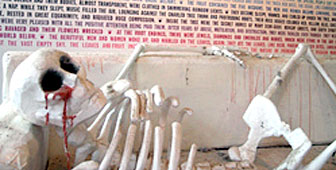New York’s Swiss Institute gives clichés a miss

The Swiss Institute of Contemporary Art is carving out a niche for itself by staging some of the most experimental art exhibitions in New York.
A recent show by the Swiss artist, Urs Fischer, showed skeletons draped over benches and garish, childlike drawings of severed body parts. A background soundtrack told the story of a rotting tree, written and narrated by New York poet John Giorno.
According to artistic director Marc-Olivier Wahler, the institute’s often bizarre or unsettling exhibitions are a far cry from the cosy images of Switzerland as an Alpine haven.
He says it is looking to compete with the most cutting-edge galleries in the city’s saturated art scene, working in collaboration with young Swiss and American artists, many of them still unknown.
“It’s very important to give young artists an opportunity, a platform, just as older, better known artists need to be given new instruments and challenges,” Wahler told swissinfo.
“Everybody thinks contemporary art is elitist or incomprehensible … that used to be the case but nowadays, artists use society and urban life as a subject matter, which makes it a lot more accessible.”
Artistic dialogue
Founded in 1986 to promote artistic dialogue between Switzerland and the United States, the institute lies in the heart of the city’s art world, in SoHo’s historic New Era Building.
And despite the gallery’s less-than-mainstream appeal, Wahler is confident it has secured a firm place in the New York art scene. He says visitor numbers are rising steadily as a result of positive press reviews.
He also believes the move to rename the institute by adding the words “contemporary art” has helped to demystify its role.
“Here in New York it’s very important to be seen and to have a clear identity,” explains Wahler. “At the start, in the mid-80s, the institute used to stage more piano concerts and cultural functions, whereas now, when people think about the Swiss institute, they immediately think about edgy, contemporary art.”
And while the gallery doesn’t directly promote Switzerland, Wahler says it succeeds in providing a shop window for budding talents from his native country.
“I think the best advertising for a country is to show creativity and dynamism – you can do this by making fondue, but I do it by showing the art and the energy of young artists,” he says.
Private sponsorship
In addition to providing a platform for new art, the institute also has to cast a sharp eye on attracting sponsorship from private and corporate investors, as only 30 per cent of funding comes from the Swiss government.
Wahler says one drawback of such limited funding is that the gallery can never hope to compete with larger exhibitions of Swiss artists, such as last year’s major retrospective of Alberto Giacometti at the New York Museum of Modern Art.
But on the plus side, the institute’s financial independence allows its art director to stage precisely what he wants, even though this is more likely to draw a smattering of art aficionados rather than a more mainstream audience.
“Places like the Swiss Institute can afford to play around more – it’s not about selling everything on the wall, but more about the experience of the actual show. So I like that … it’s experimental,” said a trainee curator visiting the institute.
by Vanessa Mock

In compliance with the JTI standards
More: SWI swissinfo.ch certified by the Journalism Trust Initiative









You can find an overview of ongoing debates with our journalists here . Please join us!
If you want to start a conversation about a topic raised in this article or want to report factual errors, email us at english@swissinfo.ch.